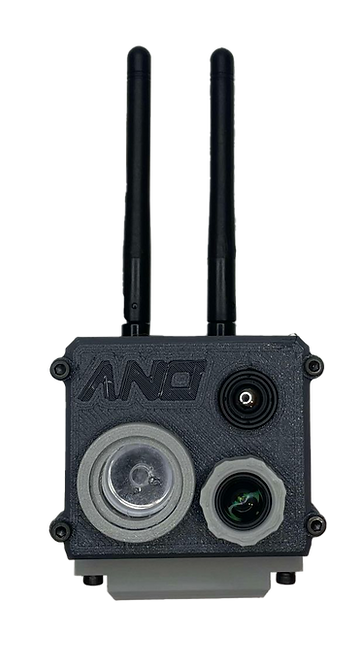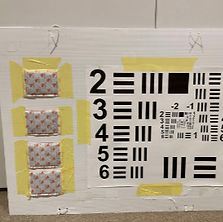
Honors Thesis:
Thermal Fusion Night vision for Wildlife Study [2024]
This project focuses on developing a cost-effective digital night vision system tailored for nocturnal wildlife studies. The goal was to create an accessible and practical alternative to expensive night vision solutions, enabling researchers and conservationists to observe and document nocturnal wildlife with improved clarity and precision.
Traditional Nocturnal Wildlife study methods
often face challenges in effectively gathering imaging data, making it difficult to locate, identify, and catalog wildlife. Traditional methods utilizing spotlights can be disruptive to wildlife and ineffective under various environmental conditions.

Thermal Imaging
is sometimes used for detecting wildlife through their heat signatures but cannot see visual biological features, such as fur patterns, which are essential for determining factors like species and age.

Thermal Fusion
Imaging overlays imagery from a thermal sensor with that of a digital night vision camera, enhancing the biological detection and low-light imaging capabilities of both systems. Adapted from military-grade night vision methodologies, this approach inexpensively meets the imaging requirements of nocturnal wildlife studies.



Project Outcome
The outcome of this project is a comprehensive thesis that explores the contextualization, development, and testing of new night vision systems for nocturnal wildlife studies. It provides an in-depth analysis of existing technologies, how they were adapted to the needs of nocturnal wildlife studies through a user-centric design approach, and how their effectiveness was validated through collaboration with wildlife ecologists.
From a technical standpoint, the thesis details the practical development of these systems, including the imaging methodology, hardware design, and product iterations. It thoroughly documents the testing methods, iterative design process, and prototyping stages, offering a detailed account of the challenges, refinements, and insights gained throughout development.


Thermal Fusion Night Vision Goggles and Drone Camera Systems
represent the product outcomes of this honors research project, providing researchers with real time thermal fusion imagery. Developed with input from nocturnal wildlife ecology researchers, these devices represent two common systems used in conducting nocturnal wildlife studies.


256x192 Thermal
Cameras
are used on both prototypes, providing adequate thermal imaging resolution while keeping cost low.
Low light Cameras
Provide visible and infrared night
vision imagery.
Infrared Spotlights
Provide invisible illumination in extreme low light scenarios.


Helmet Mounted Night Vision Goggle system
Allows for night time navigation and motion tracking, as well as magnified imagery for long-range observation, providing the user with real-time thermal fusion imagery.
.png)
Thermal fusion drone camera system
provides remote imagery, utilizing remote image processing to forgo the need for computing hardware in the camera system, with image blending and display taking place on a ground station computer.

Project Research
Process
A Staged Approach
The research and development process was taken to evaluate the feasibility of producing a low-cost thermal fusion system. Contextual research into nocturnal wildlife studies, night vision equipment, and low-light imaging techniques informed the imaging methodology and design strategy chosen to meet the imaging needs of nocturnal wildlife studies.
The iterative design and development phases refined firmware, hardware, and functionality, coupled with iterative testing of the systems produced. This process was guided by a user-centric approach, and provided deeper insights into the development of night vision systems tailored to nocturnal wildlife studies.
Note: The research and development process began with contextual research into nocturnal wildlife study methods (first slide), followed by the design and development of thermal fusion imaging systems (second slide). The systems and approach were validated through testing (third slide). (Angus Logue, 2024)









Firmware Optimization and Hardware Design
phases focused on enhancing firmware efficiency, selecting the target processing hardware while integrating user controls, display, and power components. The physical form of the devices was designed to support these elements, ensuring an ergonomic, functional and rugged outcome.
Field Research
identified key imaging objectives for nocturnal wildlife studies through literature and expert engagement: locating, observing, and identifying species while minimizing disruption to their natural behavior.
Existing thermal imaging systems lack the visual detail needed to identify biological markers such as banding and fur patterns, critical for species identification. Similarly, equipment like spotlights proved highly disruptive to wildlife.
Thermal fusion imagery emerged as a highly effective solution, combining heat detection with the ability to capture essential visual details for biological identification.
Note: Thermal imaging cameras (top) are unable to detect visual detail, while night vision cameras an thermal fusion device are able to detect both heat sources and visual detail (bottom). (Angus Logue, 2024)
Proof of Concept
platforms were developed to evaluate imaging sensors in low-light conditions. Custom camera firmware was created to blend digital night vision and low-light imagery, demonstrating the potential for integrating thermal fusion technology into future designs.
Testing protocols were established to facilitate efficient field and laboratory evaluations of firmware performance.
Note: Low fidelity prototypes were created as a proof of concept for field and lab testing the of the thermal fusion imaging system developed (Angus Logue, 2024)




Note: Both Firmware and Hardware development are undertaken to incorporate the developed thermal fusion camera system into two high fidelity prototypes. (Angus Logue, 2024)

Expert Validation and Testing
The design approach was validated through collaboration with a nocturnal wildlife studies expert, who assessed the imaging requirements and methodology underpinning the project.
Testing and validation activities empirically measured the system’s performance. Existing night vision testing methodologies were adapted to evaluate both infrared and thermal imaging capabilities, aligning with the multi-spectral functionality of the thermal fusion system.


Note: Testing the systems outdoors (top) Adapting imaging resolution testing to work across both the infrared and thermal imaging spectrum Bottom left and right). (Angus Logue, 2024)

Significance in Project Outcomes And Future Development
This project combined contextual research, iterative design development, and validation to identify imaging, practical, and user-centered requirements for night vision systems in nocturnal wildlife studies.
The resulting design outcomes include two innovative outcomes: an affordable thermal fusion night vision goggle system and a drone camera system. These prototypes highlight the advantages of thermal fusion imaging, such as enhanced low-light performance, detailed visual capture, and biological detection.
Expert engagement and testing validated the designs while uncovering limitations, including resolution constraints due to portable processing in the goggles and transmission issues in the drone system. Addressing these challenges will further enhance the systems’ ability to capture detailed, thermally enhanced imagery.
Beyond the specific prototypes, the project expanded my knowledge in designing and prototyping complex electro-optical systems, addressing user needs, and integrating ergonomic considerations into a complex outcome.
(Background) Note: The thermal fusion night vision goggles and drone camera system developed in this project (Angus Logue, 2024)
Moving forward, these prototypes demonstrate my ability to research, understand, and develop complex systems as design solutions. They highlight my skills in electronics design while serving as a foundation for further development of practical, field-ready thermal fusion night vision systems.